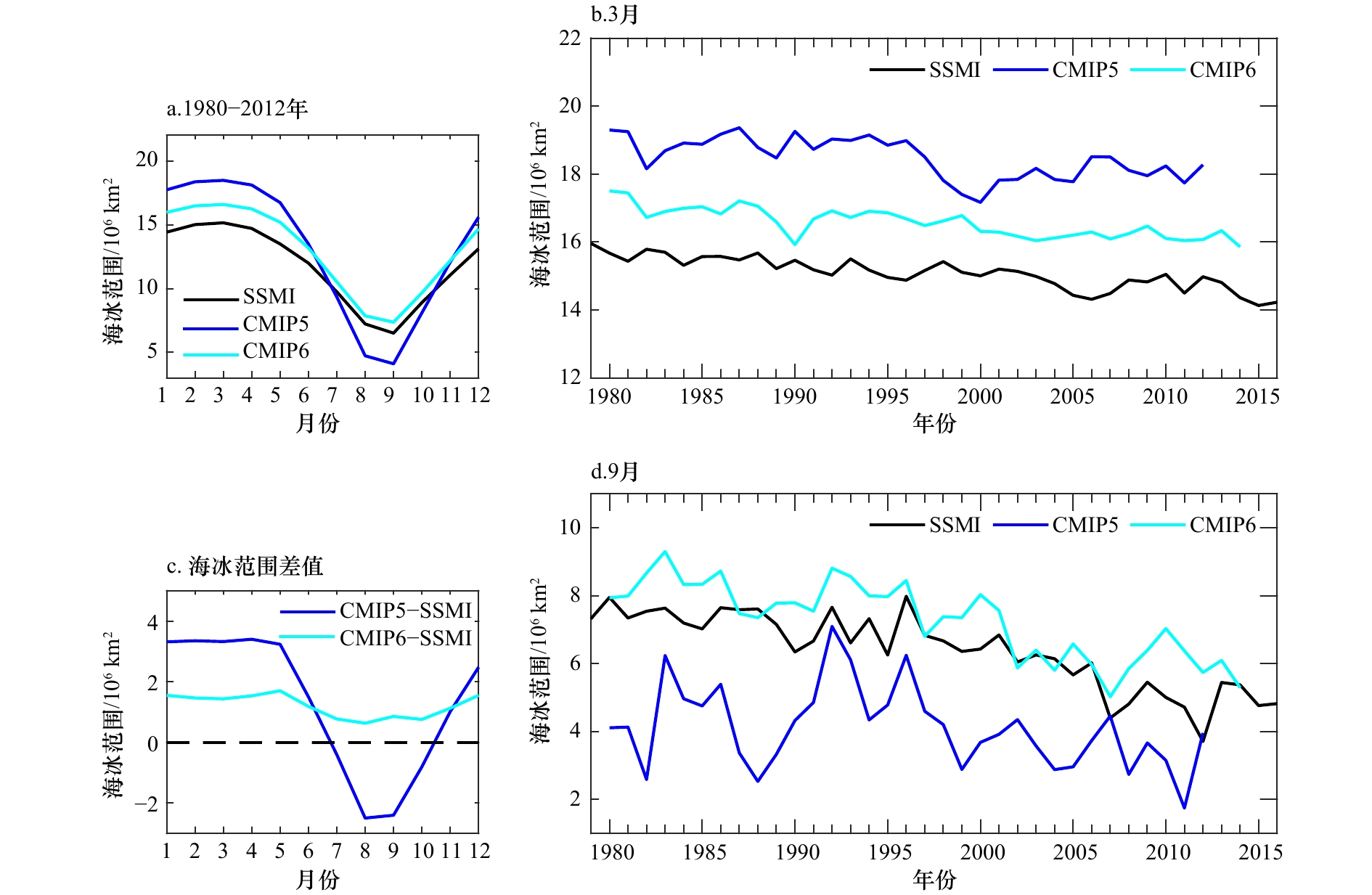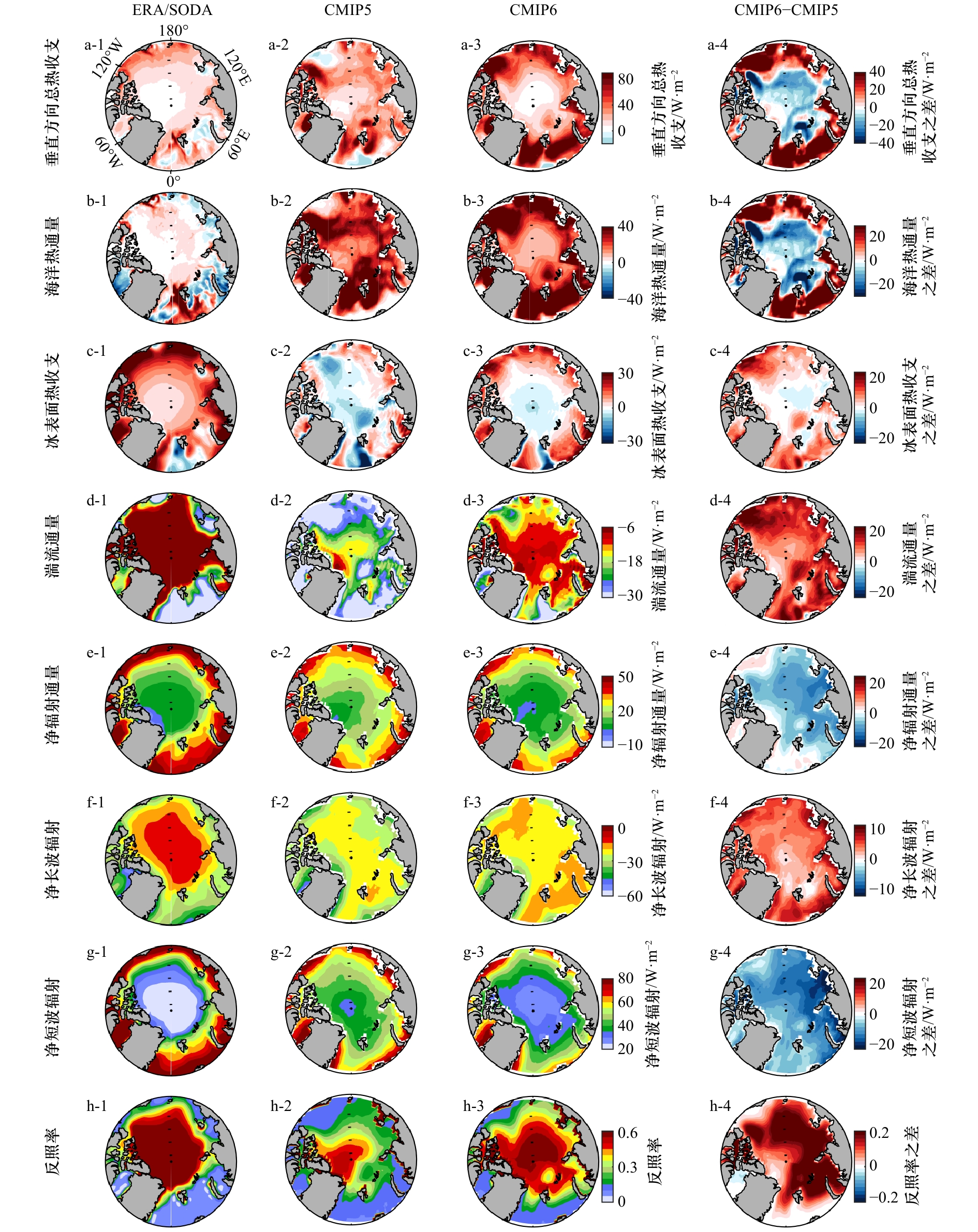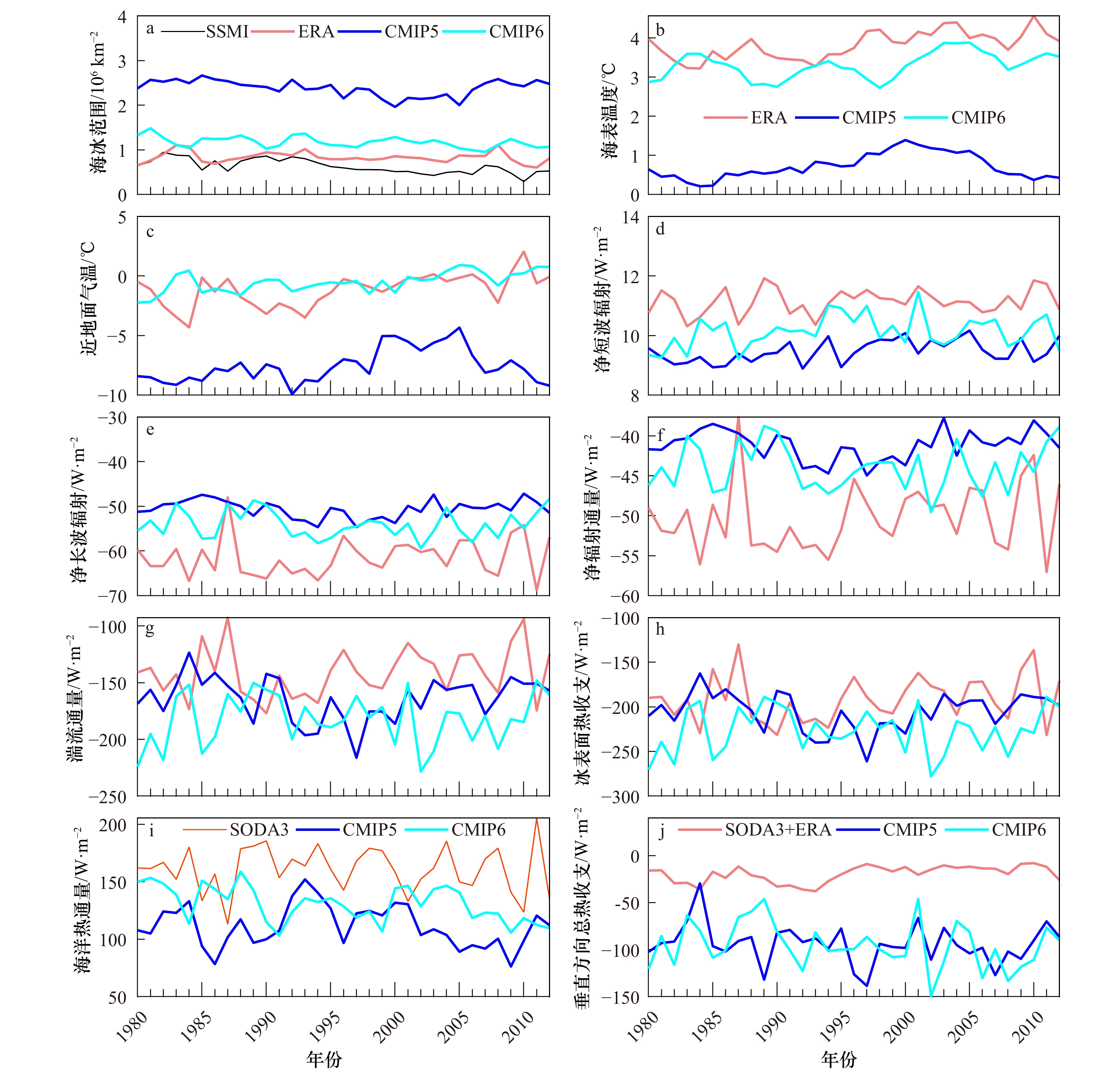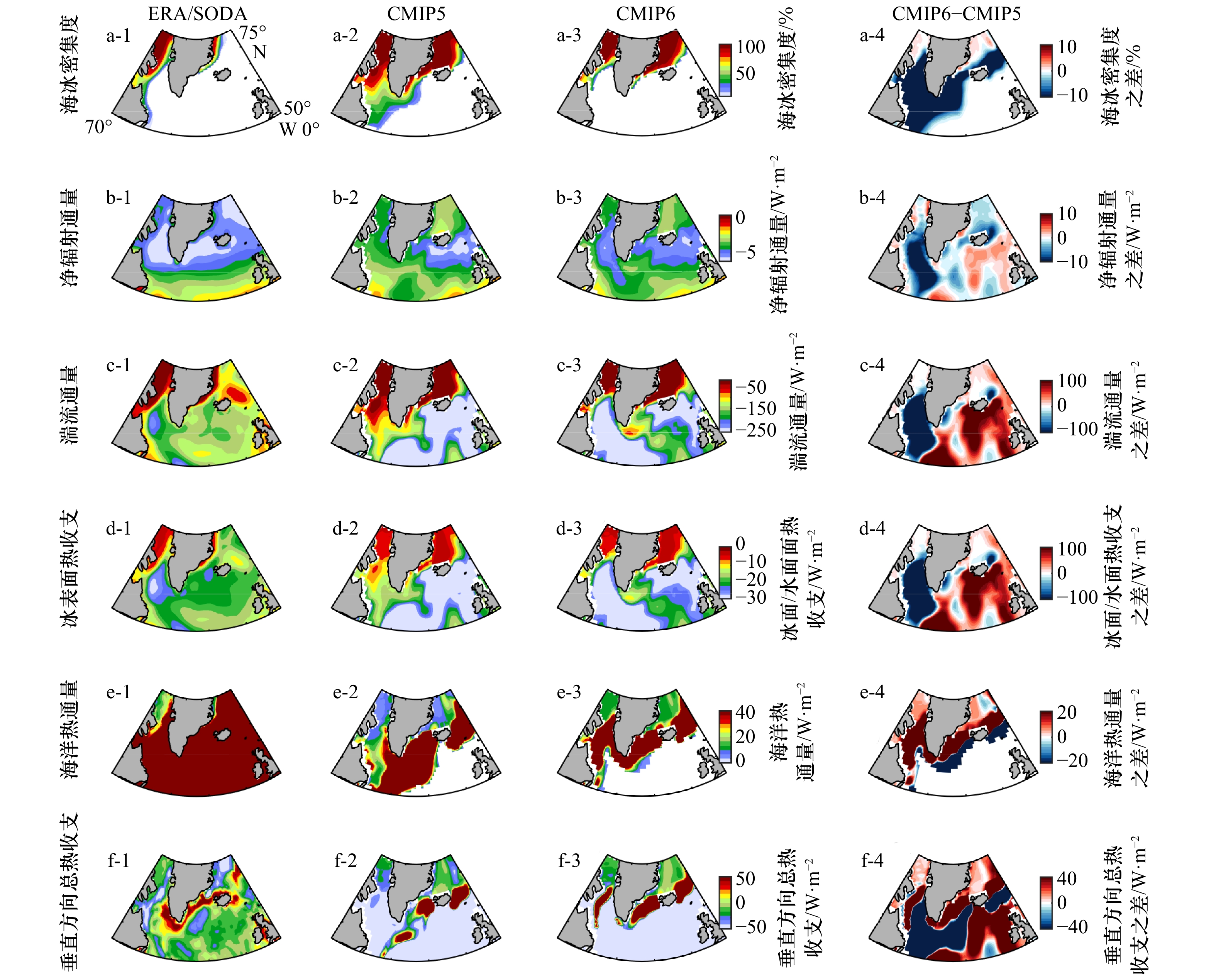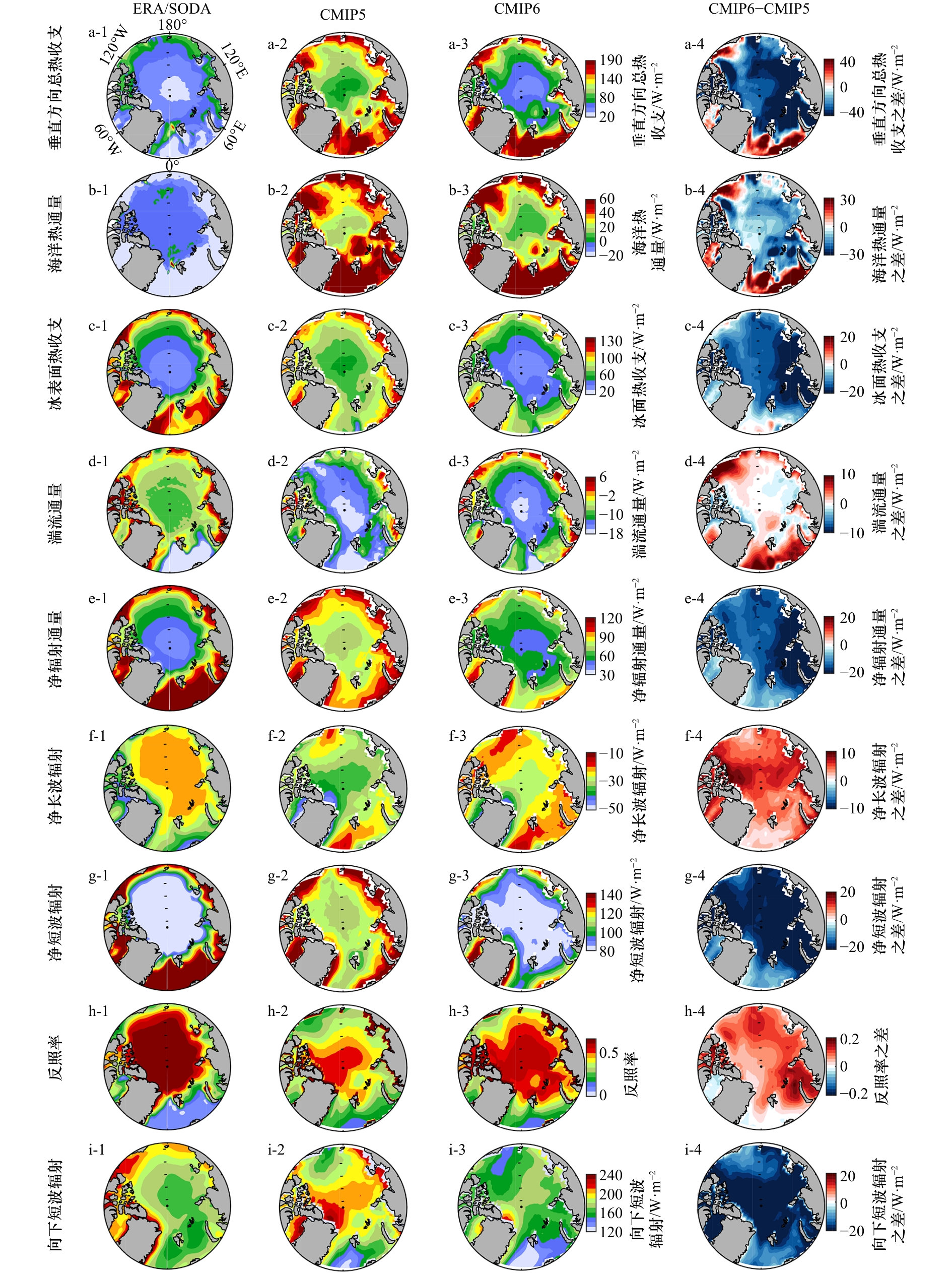Comparison of simulation results of the Arctic sea ice by BCC_CSM: CMIP5 and CMIP6 historical experiments
-
摘要: 本文利用北京气候中心气候系统模式(BCC_CSM)在最近两个耦合模式比较计划(CMIP5和CMIP6)的历史试验模拟结果,对北极海冰范围和冰厚的模拟性能进行了比较,结果表明:(1) CMIP6改善了CMIP5模拟海冰范围季节变化过大的问题,总体上更接近观测结果;(2)两个CMIP试验阶段中BCC_CSM模拟的海冰厚度都偏小,但CMIP6试验对夏季海冰厚度过薄问题有所改进。通过对影响海冰生消过程的冰面和冰底热收支的分析,我们探讨了上述模拟偏差以及CMIP6模拟结果改善的成因。分析表明,8−9月海洋热通量、向下短波辐射和反照率对模拟结果的误差影响较大,CMIP6试验在这些方面有较大改善;而12月至翌年2月,CMIP5模拟的北极海冰范围偏大主要是海洋热通量偏低所导致,CMIP6模拟的海洋热通量较CMIP5大,但北大西洋表层海流的改善才是巴芬湾附近海冰外缘线位置改善的主要原因。CMIP试验模拟的夏季海冰厚度偏薄主要是因为6−8月海洋热通量和冰面热收支都偏大,而CMIP6试验模拟的夏季海冰厚度有所改善主要是由于海洋热通量和净短波辐射的改善。海冰模拟结果的改善与CMIP6海冰模块和大气模块参数化的改进有直接和间接的关系,通过改变短波辐射、冰面反照率和海洋热通量,使BCC_CSM模式对北极海冰的模拟性能也得到有效提高。Abstract: In this paper, the simulation performance of the sea ice concentration, ice extent/area, and ice thickness of the Arctic is compared based on the results of the climate system model of Beijing Climate Center (BCC_CSM) in the recent two coupling model comparison programs (CMIP5 and CMIP6). The results show that, compared with the results in the CMIP5, the CMIP6 historical experiment recently released has different degrees of improvement in the Arctic sea ice extent seasonal cycle and sea ice thickness, which are shown as follows: (1) In the CMIP6 experiment, the simulated sea ice extent in summer is larger, while the sea ice extent in winter is smaller, which is generally closer to the observation result than the CMIP5. (2) The sea ice thickness simulated by BCC_CSM in the two CMIP is relatively small, but the CMIP6 experiment slightly improves the problem of excessively thin sea ice thickness. Through the analysis of the variables (such as SST, air temperature and radiation flux, turbulent heat flux, ocean heat flux) in different spheres of the climate system affecting the sea ice process, we discuss the causes of the above simulation errors and the improvement of CMIP6 simulation results. The analysis shows that the Arctic sea ice extent simulated by BCC_CSM model in CMIP5 from August to September is small, which is mainly caused by greater ocean heat flux, larger downward short-wave radiation and smaller albedo, while CMIP6 experiment has a great improvement in these aspects. From December to February, the Arctic sea ice extent simulated by CMIP5 is relatively large mainly because of the low ocean heat flux, and the ocean heat flux simulated by CMIP6 is larger than that of CMIP5. However, the improvement of the north Atlantic regional ocean surface current is the main reason for the improvement of the sea ice extent in this region, especially the sea ice edge in the Baffin Bay. The thinner summer sea ice thickness simulated by CMIP5 is mainly due to the larger ocean heat flux and ice surface heat budget from June to August, while the improvement of sea ice thickness simulated by CMIP6 is mainly due to the improvement of ocean heat flux and net short-wave radiation. The improvement of sea ice simulation has direct and indirect relationship with CMIP6 sea ice module and atmospheric module parameterization. By changing short-wave radiation, ice surface albedo and ocean heat flux, the performance of BCC_CSM mode on Arctic sea ice has been effectively improved.
-
Key words:
- BCC_CSM /
- climate system models /
- Arctic sea ice /
- CMIP5 /
- CMIP6
-
图 5 再分析数据及模拟的8−9月垂直方向总热收支、海洋热通量、冰表面热收支、湍流通量、净辐射通量、净长波辐射、净短波辐射、反照率的分布
Fig. 5 Distribution of vertical total heat budget, ocean heat flux, surface heat balance, turbulent flux, net radiation flux, net long-wave radiation, net short-wave radiation, and albedo in August and September from reanalysis data and simulation results
图 7 冬季大西洋海区平均海冰范围(a)、海表温度(b)、近地面气温(c)、净短波辐射(d)、净长波辐射(e)、净辐射通量(f)、湍流通量(g)、冰面热收支(h)、海洋热通量(i)、垂直方向总热收支(j)的年际变化
Fig. 7 Interannual variation of average sea ice extent (a), sea surface temperature (b), near-surface temperature (c), net short-wave radiation (d), net long-wave radiation (e), net radiation flux (f), turbulent flux (g), ice surface heat balance (h), ocean heat flux (i), and vertical total heat budget (j) of the Atlantic region in winter
图 10 6−8月垂直方向总热收支、海洋热通量、冰面热收支、湍流通量、净辐射通量、净长波辐射、净短波辐射、反照率、向下短波辐射的分布
Fig. 10 Distribution of vertical total heat budget, ocean heat flux, ice surface heat balance, turbulent flux, net radiation flux, net long-wave radiation, net short-wave radiation, albedo, and downward short-wave radiation from June to August
图 11 6−8月75°N以北区域平均的近地面气温(a)、海表面温度(b)、反照率(c)、向下短波辐射(d)、净短波辐射(e)、向下长波辐射(f)、净长波辐射(g)、净辐射通量(h)、湍流通量(i)、冰表面热收支(j)、海洋热通量(k)、垂直方向总热收支(l)的年际变化
Fig. 11 Interannual variability of the area average surface air temperature (a), sea surface temperature (b), albedo (c), downward short-wave radiation (d), net shortwave radiation (e), downward long-wave radiation (f), net long wave radiation (g), net radiation flux (h), turbulent flux (i), the ice surface heat balance (j) , the ocean heat flux (k) , and vertical total heat budget (l) of the area north of 75 ° N from June to August
表 1 CMIP5与CMIP6试验阶段BCC_CSM模式各分量模式信息
Tab. 1 Component mode information of BCC_CSM mode in CMIP5 and CMIP6
模式版本 CMIP5试验的BCC-CSM1.1m模式 CMIP6试验的BCC-CSM2-MR模式 大气模式分量 BCC-AGCM2.2
T106,26层,顶层为2.917 hPaBCC-AGCM3-MR
(1)T106,46层,顶层为1.459 hPa;(2)云物理,辐射传输和边界层等过程参数化方案的改进陆面模式分量 BCC-AVIM1.0 BCC-AVIM2.0 海洋模式分量 MOM4-L40v2 MOM4-L40v2 海冰模式分量 SISv2 SISv2冰面湍流通量参数化方案改进海冰反照率相关参数优化 -
[1] Comiso J C, Parkinson C L, Gersten R, et al. Accelerated decline in the Arctic sea ice cover[J]. Geophysical Research Letters, 2008, 35(1): L01703. [2] Perovich D K, Richter-Menge J A. Loss of sea ice in the Arctic[J]. Annual Review of Marine Science, 2009, 1: 417−441. doi: 10.1146/annurev.marine.010908.163805 [3] Stroeve J C, Kattsov V, Barrett A, et al. Trends in Arctic sea ice extent from CMIP5, CMIP3 and observations[J]. Geophysical Research Letters, 2012, 39(16): L16502. [4] Serreze M C, Stroeve J. Arctic sea ice trends, variability and implications for seasonal ice forecasting[J]. Philosophical Transactions of the Royal Society A: Mathematical, Physical and Engineering Sciences, 2015, 373(2045): 20140159. doi: 10.1098/rsta.2014.0159 [5] Stroeve J, Holland M M, Meier W, et al. Arctic sea ice decline: faster than forecast[J]. Geophysical Research Letters, 2007, 34(9): L09501. [6] Rothrock D A, Percival D B, Wensnahan M. The decline in arctic sea-ice thickness: separating the spatial, annual, and interannual variability in a quarter century of submarine data[J]. Journal of Geophysical Research: Oceans, 2008, 113(C5): C05003. [7] Kwok R, Rothrock D A. Decline in Arctic sea ice thickness from submarine and ICESat records: 1958−2008[J]. Geophysical Research Letters, 2009, 36(15): L15501. [8] Maksym T. Arctic and Antarctic Sea ice change: contrasts, commonalities, and causes[J]. Annual Review of Marine Science, 2019, 11: 187−213. doi: 10.1146/annurev-marine-010816-060610 [9] Johnson M, Gaffigan S, Hunke E, et al. A comparison of Arctic Ocean sea ice concentration among the coordinated AOMIP model experiments[J]. Journal of Geophysical Research: Oceans, 2007, 112(C4): C04S11. [10] Johnson M, Proshutinsky A, Aksenov Y, et al. Evaluation of Arctic sea ice thickness simulated by Arctic Ocean Model Intercomparison Project models[J]. Journal of Geophysical Research: Oceans, 2012, 117(C8): C00D13. [11] Vavrus S J, Bhatt U S, Alexeev V A. Factors influencing simulated changes in future Arctic cloudiness[J]. Journal of Climate, 2011, 24(18): 4817−4830. doi: 10.1175/2011JCLI4029.1 [12] Winton M. Do climate models underestimate the sensitivity of Northern Hemisphere sea ice cover?[J]. Journal of Climate, 2011, 24(15): 3924−3934. doi: 10.1175/2011JCLI4146.1 [13] Kattsov V M. Climate prediction: progress, problems, and prospects[J]. Russian Meteorology and Hydrology, 2010, 35(1): 10−12. doi: 10.3103/S1068373910010024 [14] Kay J E, Holland M M, Jahn A. Inter-annual to multi-decadal Arctic sea ice extent trends in a warming world[J]. Geophysical Research Letters, 2011, 38(15): L15708. [15] 邱博, 张录军, 储敏, 等. 气候系统模式对于北极海冰模拟分析[J]. 极地研究, 2015, 27(1): 47−55.Qiu Bo, Zhang Lujun, Chu Min, et al. Performance analysis of Arctic sea ice simulation in climate system models[J]. Chinese Journal of Polar Research, 2015, 27(1): 47−55. [16] 王秀成, 刘骥平, 俞永强, 等. FGOALS_g1.1极地气候模拟[J]. 气象学报, 2009, 67(6): 961−972.Wang Xiucheng, Liu Jiping, Yu Yongqiang, et al. Polar climate simulation in FGOALS_g1.1[J]. Acta Meteorologica Sinica, 2009, 67(6): 961−972. [17] 王秀成, 刘骥平, 俞永强, 等. 海冰模式CICE4.0与LASG/IAP气候系统模式的耦合试验[J]. 大气科学, 2010, 34(4): 780−792. doi: 10.3878/j.issn.1006-9895.2010.04.10Wang Xiucheng, Liu Jiping, Yu Yongqiang, et al. Experiment of coupling sea ice model CICE4. 0 to LASG/IAP climate system model[J]. Chinese Journal of Atmospheric Sciences, 2010, 34(4): 780−792. doi: 10.3878/j.issn.1006-9895.2010.04.10 [18] 舒启, 乔方利, 宋振亚. 地球系统模式FIO-ESM对北极海冰的模拟和预估[J]. 海洋学报, 2013, 35(5): 37−45.Shu Qi, Qiao Fangli, Song Zhenya. The hindcast and forecast of Arctic sea ice from FIO-ESM[J]. Haiyang Xuebao, 2013, 35(5): 37−45. [19] 朱清照, 闻新宇. 中国CMIP5模式对未来北极海冰的模拟偏差[J]. 气候变化研究进展, 2016, 12(4): 276−285. doi: 10.12006/j.issn.1673-1719.2015.204Zhu Qingzhao, Wen Xinyu. Performance of Chinese climate models in simulating Arctic sea-ice in CMIP5 experiments[J]. Climate Change Research, 2016, 12(4): 276−285. doi: 10.12006/j.issn.1673-1719.2015.204 [20] Flato G, Marotzke J, Abiodun B, et al. Evaluation of climate models[M]//Stocker T F, Qin D, Plattner G K, et al. Climate Change 2013: The Physical Science Basis. Contribution of Working Group I to the Fifth Assessment Report of the Intergovernmental Panel on Climate Change. Cambridge: Cambridge University Press, 2013: 787−789. [21] 谭慧慧, 张录军, 储敏, 等. BCC_CSM对全球海冰面积和厚度模拟及其误差成因分析[J]. 大气科学, 2015, 39(1): 197−209. doi: 10.3878/j.issn.1006-9895.1404.13301Tan Huihui, Zhang Lujun, Chu Min, et al. An analysis of simulated global sea ice extent, thickness, and causes of error with the BCC_CSM model[J]. Chinese Journal of Atmospheric Sciences, 2015, 39(1): 197−209. doi: 10.3878/j.issn.1006-9895.1404.13301 [22] 房永杰, 储敏, 吴统文, 等. CICE5.0与BCC_CSM2.0模式的耦合及对北极海冰的模拟评估[J]. 海洋学报, 2017, 39(5): 33−43.Fang Yongjie, Chu Min, Wu Tongwen, et al. Couping of CICE5.0 with BCC_CSM2.0 model and its performance evaluation on Arctic sea ice simulation[J]. Haiyang Xuebao, 2017, 39(5): 33−43. [23] Eyring V, Bony S, Meehl G A, et al. Overview of the Coupled Model Intercomparison Project Phase 6(CMIP6) experimental design and organization[J]. Geoscientific Model Development, 2016, 9(5): 1937−1958. doi: 10.5194/gmd-9-1937-2016 [24] Wu Tongwen, Lu Yixiong, Fang Yongjie, et al. The Beijing Climate Center Climate System Model (BCC-CSM): the main progress from CMIP5 to CMIP6[J]. Geoscientific Model Development, 2019, 12(4): 1573−1600. doi: 10.5194/gmd-12-1573-2019 [25] Wu Tongwen, Song Lianchun, Li Weiping, et al. An overview of BCC climate system model development and application for climate change studies[J]. Journal of Meteorological Research, 2014, 28(1): 34−56. [26] Wu Tongwen, Li Weiping, Ji Jinjun, et al. Global carbon budgets simulated by the Beijing Climate Center Climate System Model for the last century[J]. Journal of Geophysical Research: Atmospheres, 2013, 118(10): 4326−4347. doi: 10.1002/jgrd.50320 [27] Xin Xiaoge, Wu Tongwen, Li Jianglong, et al. How well does BCC_CSM1. 1 reproduce the 20th century climate change over China?[J]. Atmospheric and Oceanic Science Letters, 2013, 6(1): 21−26. doi: 10.1080/16742834.2013.11447053 [28] Lu Yixiong, Zhou Mingyu, Wu Tongwen. Validation of parameterizations for the surface turbulent fluxes over sea ice with CHINARE 2010 and SHEBA data[J]. Polar Research, 2013, 32(1): 20818. doi: 10.3402/polar.v32i0.20818 [29] Cavalieri D J, Parkinson C L, Gloersen P, et al. Sea ice concentrations from Nimbus-7 SMMR and DMSP SSM/I-SSMIS passive microwave data[R]. Boulder, Colorado USA: NASA National Snow and Ice Data Center Distributed Active Archive Center, 1996. [30] Dee D P, Uppala S M, Simmons A J, et al. The ERA-Interim reanalysis: configuration and performance of the data assimilation system[J]. Quarterly Journal of the Royal Meteorological Society, 2011, 137(656): 553−597. doi: 10.1002/qj.828 [31] Zhang Jinlun, Rothrock D A. Modeling global sea ice with a thickness and enthalpy distribution model in generalized curvilinear coordinates[J]. Monthly Weather Review, 2003, 131(5): 845−861. doi: 10.1175/1520-0493(2003)131<0845:MGSIWA>2.0.CO;2 [32] Carton J A, Chepurin G, Cao Xianhe. A simple ocean data assimilation analysis of the global upper ocean 1950-95. Part II: results[J]. Journal of Physical Oceanography, 2000, 30(2): 311−326. doi: 10.1175/1520-0485(2000)030<0311:ASODAA>2.0.CO;2 [33] Stroeve J, Serreze M, Drobot S, et al. Arctic sea ice extent plummets in 2007[J]. Eos, Transactions American Geophysical Union, 2008, 89(2): 13−14. doi: 10.1029/2008EO020001 [34] Parkinson C L, Comiso J C. On the 2012 record low Arctic sea ice cover: combined impact of preconditioning and an August storm[J]. Geophysical Research Letters, 2013, 40(7): 1356−1361. doi: 10.1002/grl.50349 [35] Vaughan D G, Comiso J C, Allison I, et al. Observations of the cryosphere[M]//Stocker T F, Qin D, Plattner G K, et al. Climate Change 2013: The Physical Science Basis. Contribution of Working Group I to the Fifth Assessment Report of the Intergovernmental Panel on Climate Change. Cambridge: Cambridge University Press, 2013: 317−382. -




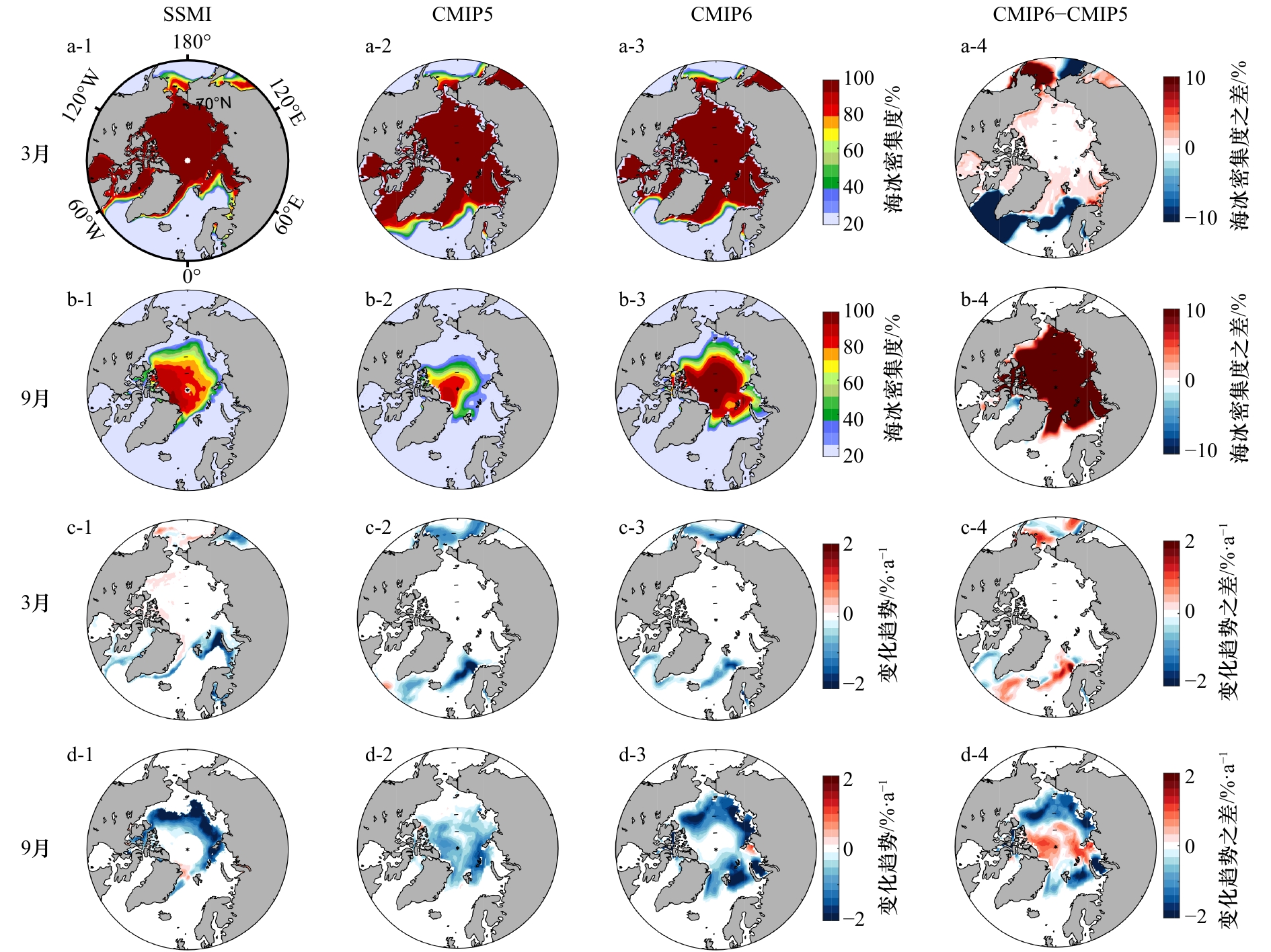
 下载:
下载:
